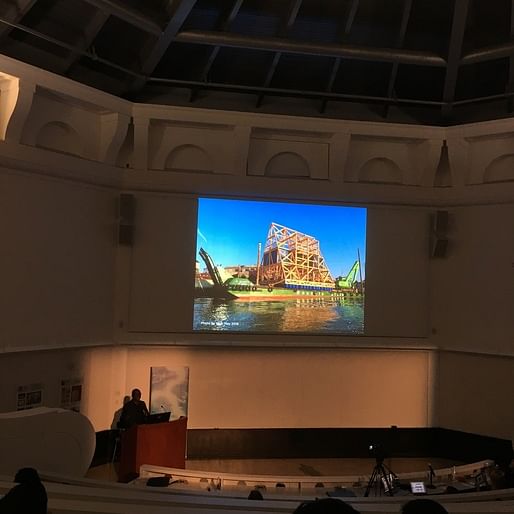

“Cities are man’s greatest achievements, and also man’s deadliest inventions”, stated Kunlé Adeyemi in his evening lecture at the University of Miami School of Architecture. The Nigerian born, Netherlands based architect was on hand addressing a full house as part of the 2016-2017 Tecnoglass Lecture series. With this year’s topic being “water”, it was only a natural choice for Adeyemi to speak as he has received critical acclaim for his research into the urbanization of coastal cities in Africa.

Instead of spending the evening speaking about his past projects at OMA or the work being done at his firm, NLE, Adeyemi started the evening talking about methodologies and the driving forces of his practice. His interests lie in the opportunities that individual communities can provide to resolve global challenges which he presents as two procedures. The first being the idea of “Sustainable Development”, defined by the World Commission on Environment as “Development that meets the needs of the present without compromising the ability of future generations to meet their own ends”. It’s through this development that we promise better development, putting future generations at a more advantageous position. Adeyemi argues this type of development will allow architects to think, build, and live differently. They will design for better strategies of the city as a whole, taking into account outlying peripheries such as villages, rural areas, and countryside.

The second was an acronym called “DESIMER”, which stands for Demographics, Economy, Socio-Politics, Infrastructure, Morphology, Environment, Resources. It is an analytical approach to looking at a specific place or site to understand it as a whole, identifying challenges and its inherent capabilities. To explain this process, he uses Florida as a case study for his DESIMER research model, highlighting the state’s tourism and agriculture base, its different ethnic groups by county, transportation capabilities, the unique environment along with environmental impacts, and the opportunities found in its natural resources.

Adeyemi presents the aforementioned project implemented in the fishing village of Makoko. Makoko is covered entirely by water, impoverished, with no roads to speak of, however it continues to grow, has an abundance of aquaculture, an experienced workforce, and a knowledge of how to navigate the existing flooded condition. Adeyemi builds upon these resources to create the floating school as a structurally rigid prototype that would be built using only the tools found within the population. Its tall triangular frame sits atop a barge of floating barrels, and allows the structure to gain more space by creating two floors above the platform. In return, the community receives an iconic communal space that towers above the existing architecture. It proves to be a didactic structure, not just because of its programming, but how it inspired a variety of architects to duplicate similar projects after its creation. Even Adeyemi himself saw opportunity to improve upon the project when he developed MFS II for the Venice Biennale. The Biennale allowed Adeyemi to industrialize his process, ironically building it on land, and in only 10 days thus opening the possibilities of modularity. He jests that an unintentional outcome of this process was paying homage to Aldo Rossi’s Teatro del Mondo as photos instantly recalls the structure being towed into Venice.

Adeyemi’s approach to architecture is less about flash, opting to focus on well researched information and subtle architectural tectonics. Only in his early 40’s, his reputation precedes him; at the lecture he announced that he will be frequenting Miami more often as he will be working with Perking + Will on the upcoming Miami Museum of Contemporary Art of the African Diaspora. It is fortuitous and fortunate that Adeyemi will be connected to Miami now since the city faces major challenges in its future. History has shown that many great cities have been founded close to water for its resources, climate change has made these strategies very risky. Miami, a major coastal city in the United States is predicted to be in great peril relatively soon. It’s once valuable resource, something that drives its local economy, is also its harbinger of collapse. However, if Adeyemi leaves us with anything, it is that there will always be challenges and there will always be opportunities. The strategy is best observed to take the lessons learned from those that are already facing these challenges, advance them, and develop new ways to live and adapt.

This blog gives a sneak peak into the architecture world at the University of Miami. What began as an experiment following one group of incoming graduate students through their first semester of design, has morphed into a window of the school of architecture through this professor's eyes. I will try to post as often as possible.
No Comments
Block this user
Are you sure you want to block this user and hide all related comments throughout the site?
Archinect
This is your first comment on Archinect. Your comment will be visible once approved.